This is a Brumberger 35, which is a rebadged Neoca 2S 35mm rangefinder camera made by Neoca Kabushiki Kaisha in Japan in 1955 and 1956. Brumberger Co. Inc. was a photographic equipment retailer, distributor, and importer based in Brooklyn, NY in the 1950s. They often imported and rebadged photographic products made by Japanese companies that otherwise wouldn’t have been available in the United States. The Brumberger 35 was a rather basic rangefinder that was well built, and had a couple features like a double stroke advance lever and central shutter which was not common in it’s price range. Despite their modest specs, both the Brumberger 35 and the Neoca 2S it was based off, were highly capable cameras.
Film Type: 135 (35mm)
Lens: 45mm f/3.5 Neokor Anastigmat coated 3-elements
Focus: 1.7 feet to Infinity
Viewfinder: Coincident Image Coupled Rangefinder
Shutter: Neoca Leaf
Speeds: B, 1 – 1/300 seconds
Exposure Meter: none
Battery: none
Flash Mount: Coldshoe and X Flash Sync
Manual: https://mikeeckman.com/media/Brumberger35Manual.pdf
History
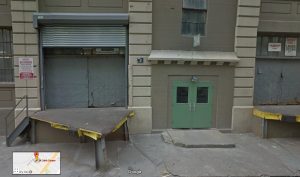
Brumberger Co. Inc., was the name of a photographic supply company based out of Brooklyn, NY from 1904 to at least the early 1960s. They had a retail store at 34 Thirty-Fourth St., Brooklyn, NY and also sold through mail order catalogs. Beyond this, I found little else about this company, it’s history, what became of it, or what it’s primary function was.
As best as I can tell, their primary business was not in the manufacture or sale of cameras, rather photographic related equipment like projectors, slide and film storage, viewers, reels, and other associated products. Google and eBay searches for the name “Brumberger” often return these types of products.
In the mid 1950s, Brumberger dabbled a bit into selling 35mm cameras, but rather than build them themselves, they chose to import two models from lesser known Japanese companies. The first model, simply called the Brumberger 35 is the model being reviewed here and was made by a company called Neoca Kabushiki Kaisha in Japan. The Brumberger 35 was an exact copy of the Neoca 2S which was a basic, but well featured camera featuring things like a double stroke film advance, between the lens shutter, and a coincident image rangefinder. Other than the presence of the word “Brumberger” on the front and top plates, the Brumberder was identical to the Neoca 2S. Interestingly, the shutter still features a “Neoca” branding and the top plate has the letters “2S’ next to the cold shoe.
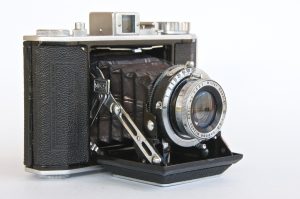
Neoca was originally founded in 1951 as Mizuho Kōki Seisakusho, not to be mistaken for Mizuho Kōgaku Kenkyūjo which was an offshoot of Olympus in the 1930s. Mizuho Kōki Seisakusho’s first products were a line of dual format 6×4.5 and 6×6 folding cameras known as the Mizuho Six. The Mizuho Six was a rather basic folding camera that really didn’t look much different from other Japanese folding cameras of the era. The body was die cast metal and were originally scale focus models. A later rangefinder version was released a year later, in 1952.
In the summer of 1954, Mizuho would announce a new 35mm folding camera that would be called the Neoca 35 in Japanese trade magazines. The camera was to have a combined rangefinder and viewfinder that was attached to the lens standard and would get folded up into the body of the camera when it was closed. It would have a fixed Neoca lens and helical focus. Unfortunately, the camera was never released and only a single prototype photo has ever been seen.
A year later, the Neoca 1S would be released which featured a more traditional body that was very similar to the Brumberger 35. It lacked the dual stroke wind lever, and instead had a wind knob, and it also lacked the self cocking feature requiring the photographer to manually cock a lever on the side of the shutter before each exposure. The Neoca 1S sold at the time for 9800 yen.
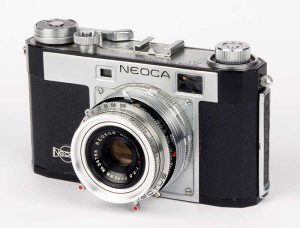
Shortly after the release of the 1S came the 2S which had a slightly revised front plate, the dual stroke film advance, and self cocking shutter with double exposure prevention. Both cameras had the same Neoca leaf shutter with speeds from 1 sec to 1/300 sec, and a Neokor 45/3.5 lens. The 2S sold for 12,500 yen.
Beyond the 2S, Neoca would continue to release new models with incremental upgrades, all the way to their last model called the Neoca SV Deluxe in 1960. The company would go bankrupt shortly after that.
I could find no information about why Brumberger chose such an unknown company like Neoca to rebadge their cameras in the United States. Perhaps it was a desperation move by Neoca to expand their products into the American market. It would seem that Neoca’s entire line was overshadowed by the massive amount of competition from other Japanese camera makers in the 1950s, and although it was probably a good idea to sell the Neoca 2S in America as the Brumberger 35, it obviously didn’t keep them alive for very long.
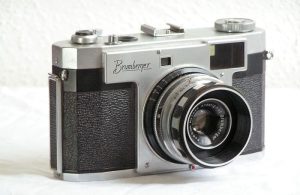
The Brumberger 35 was only sold for about 2 years. After that, Brumberger would release a second model, also called the Brumberger 35, but this time a rebadge of the Royal Camera Company’s Royal 35P from 1957. The Royal 35P was a handsome and compact 35mm rangefinder with a fixed lens and came with a variety of lenses with maximum apertures from f/1.9 to f/3.5. When sold as the Brumberger 35, the camera came with either a f/2.8 or f/3.5 lens, suggesting it was a bargain model.
The Royal Camera Company was known as Daiou Shashin Kōgaku in Japan, and was another short lived 1950s camera company that also exported it’s models to other territories under a variety of names. In addition to the Brumberger 35, the Royal 35P was also sold under the brand names Hanimex, Mansfield Skylark, Hiyoca, and Luxall.
I found about as little information about Royal as I did Neoca, and it seems as though they both went out of business around the same time. Royal’s last new model was released in 1957, but I’ve seen evidence that the Brumberger 35 was available as recently as 1960. After that time though, Neoca, Royal, and Brumberger all seemed to disappear.
Today, these models are hardly talked about. I’ve heard of a few people who have a passing interest in Neoca or Royal cameras, but I don’t think anyone remembers Brumberger. Both the Neoca and Royal built Brumberger 35s are difficult to find. I stumbled upon this model in a lot of other cameras and was pleased that it worked. It’s too bad too, because it’s a rather nice camera. The controls are logically located and its easy to use. If anyone reading this were to come across an original Neoca 2S or one of these early Brumberger 35s, I absolutely think they’re worth picking up.
My Thoughts
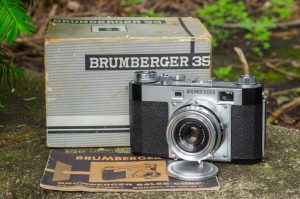
The Brumberger 35 came to me in a lot of cameras from Roberts Camera in Indianapolis, IN. It was the only one in the lot in it’s original box and a leather ever-ready case, and it even included a lens shade, a lens cloth, and the original manual (which I have scanned for this site). Considering how uncommon these are, there can’t be too many copies of this camera left in the world with all these accessories included.
Thankfully, the camera was in good working order. The body was in great shape, the lens was clear, and the shutter operated at all speeds. The only issue was that the viewfinder was very cloudy and the rangefinder patch was nearly impossible to see in anything but the brightest light. I thought I could just take the top plate off to clean things out, but I couldn’t figure out how to get it off. Try as I might, I could not get the dial on top of the wind lever to budge, so I just left it as is, and decided to shoot a roll of film with the cloudy viewfinder.

I had pretty low expectations before using this camera, but it turned out the camera was a joy to use. It is compact and fits nicely in a large pocket or small camera bag. Although mostly made of metal, the camera weighs only 481 grams which means you could lug this thing around all day without any fatigue. In bright sunlight, I was able to make out the rectangular rangefinder patch on contrasty vertical lines with ease. The rangefinder patch has a brownish tint which was probably pretty easy to see when the camera was new.
The double stroke film advance is a joy to use. The lever itself is elegantly designed with a perfect curve to the tip causing it to feel very natural in your thumb. The lever is very smooth in operation and has just the right amount of tension that it is easy to push smoothly, and it retracts back with your hand perfectly. It reminds me quite a bit of the wind lever from the Pentax Sv, which is another one of my favorites. The wind lever is a double stroke design which means you have to wind it twice for every exposure. This took a little bit of getting used to, as while I was out shooting on more than one occasion, I would try to fire the shutter, only to discover I needed to wind it again. Winding the lever makes a very satisfying mechanical ratcheting sound, reminiscent of the Leidolf Lordomat which makes the best camera winding sound I’ve ever heard. Watch this short video of the Brumberger, Lordomat, and a Nikon F (for comparison) and listen to that wonderful sound!

I didn’t really know what to expect from this camera before shooting with it. Sitting on a shelf, I appreciated the camera’s simple design. Neoca took no risks in designing the camera as all the controls are exactly where you’d expect them. This is especially impressive considering in 1955 when this camera was made, not everyone was on the same page about where things should be on cameras. Exaktas were still in high demand with their left handed shutter release, and Kodak was still turning out thousands of Retinas with controls seemingly scattered randomly across the camera body.
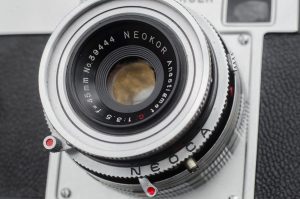
On paper, seeing a 45mm f/3.5 lens might suggest this was a cheap camera, but there was nothing that felt cheap about it. Lightweight, yes, but not cheap. I was disappointed that the viewfinder was so dirty, but that’s to be expected from 62 year old camera. I really liked the double stroke film wind and other than the times I forgot to double wind it, I never felt like it was slowing me down. Using a fully mechanical camera will always slow you down, so adding one extra step when winding the camera just felt natural.
I was on the fence about the Brumberger prior to using it, and with it’s cloudy rangefinder, I was hesitant to dedicate an entire roll to it so it shared a 36 exposure roll with the Yashica 35 that I had put into service at the same time as this camera. After shooting it, I quickly realized this was quite a nice camera, and I became motivated to take it apart and see if I could correct the hazy viewfinder issue.
Repairs
After finishing my first roll through this camera, I was unexpectedly enthralled by it, and knew that I needed to make another attempt at cleaning that rangefinder. The biggest problem I encountered was removing the wind lever, which had a metal disc over the hub, which had two divots in it for a lens spanner. Try as I might, I could not get it to budge. Worrying I was going to break something, I went online trying to find information. As it turns out, there is literally no repair info for the Neoca 2S or the Brumberger 35. I was not until I expanded my search to other Neoca models where I found a Japanese language site that offered some repair advice on a later Neoca model. Although the cameras were not the same, using Google Translate, I read that Neoca often used reverse thread screws, so I took another stab at removing the disc on top of the wind lever. Instead of lefty loosey, I used righty loosey, and sure enough, it came off!
Taking the rest of the top plate off had some challenges that I haven’t encountered with other cameras, but with some patience, I got it apart. Unfortunately, I only took two photos of the process so I don’t have a lot to share. There are a total of 6 screws that need to be removed to lift the top plate off. Unlike most cameras, the top plate on this camera is just a flat piece of metal. It does not wrap around the edges like pretty much every other camera.
In the image to the right, I have indicated with yellow arrows where all 6 screw holes are after the top is off. There are two screws beneath the rewind knob, one beneath the accessory shoe, one visible in the center of the top plate, and two more under the wind lever. If you notice, I left the winding lever attached as it is connected to a large spring. I was worried if I removed the spring, I might struggle to get it back together. Thankfully, the top can flop around with the spring still attached while you gain access to the viewfinder and rangefinder. I have also indicated with blue and red arrows where the buttons for the shutter release and rewind release should go. These are just sitting in their holes and will fall out once you remove the top plate. As long as you don’t lose them and remember where they go, you just need to set them in place when reattaching the top plate.
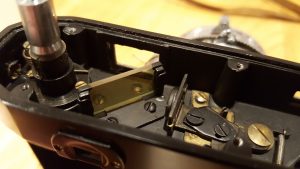 The Neoca 2S/Brumberger 35 has a very basic rangefinder. Unlike most cameras where the rangefinder assembly is self contained, the beamsplitter, mirror, and lenses for the entire assembly are out in the open once the top plate is removed. Like all beamsplitters, there is a very fragile semi-reflective material on one side of the mirror that allows some light to simultaneously pass through and reflect so that you can see both images at the same time. This semi-reflective material is on the backside of the beamsplitter, facing the film compartment. Any amount of pressure from a Q-tip or any liquid cleaner will damage this coating and render the beamsplitter inoperable, so do not touch it. You can gently wipe off the front surface of the beamsplitter with a Q-tip. Unfortunately, both sides of my beamsplitter had haze on them so I was only able to partially clean it off the front surface. I used more Q-tips and glass cleaner to clean the other viewfinder surfaces and then I put the camera back together.
The Neoca 2S/Brumberger 35 has a very basic rangefinder. Unlike most cameras where the rangefinder assembly is self contained, the beamsplitter, mirror, and lenses for the entire assembly are out in the open once the top plate is removed. Like all beamsplitters, there is a very fragile semi-reflective material on one side of the mirror that allows some light to simultaneously pass through and reflect so that you can see both images at the same time. This semi-reflective material is on the backside of the beamsplitter, facing the film compartment. Any amount of pressure from a Q-tip or any liquid cleaner will damage this coating and render the beamsplitter inoperable, so do not touch it. You can gently wipe off the front surface of the beamsplitter with a Q-tip. Unfortunately, both sides of my beamsplitter had haze on them so I was only able to partially clean it off the front surface. I used more Q-tips and glass cleaner to clean the other viewfinder surfaces and then I put the camera back together.
Without being able to fully clean every surface of the viewfinder, there was still some haze visible in my viewfinder, and there was increased contrast in the rangefinder patch, but it was still far from perfect.
My Results
As I mentioned earlier, I shared an inaugural 36 exposure roll of Kodak TMax 400 with the Yashica 35 which I had been shooting at the same time. I previously posted a review of that camera here, if you are interested in seeing what the other half of this roll looked like.
My fondness for the Brumberger grew as I used it. I found the small size of the camera to be easily portable and it’s controls to be perfectly placed. Plus, I really loved the sound of that double wind advance lever. Although my expectations were rising as I used the camera, would they be put back in check with some lackluster results from the hum-drum f/3,5 Neokor?
I can pleasantly report that my concerns for both the usage and quality of the shots from the Brumberger were completely unfounded. This might have been an entry level camera with low-specs, but it is clear that Neoca built a really nice rangefinder that produced images inconsistent with it’s spec sheet.
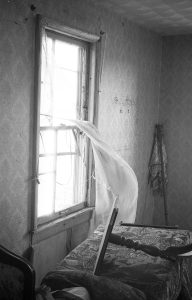
After scanning in each of the 36 images from the roll of TMax, I actually had a hard time differentiating the ones shot by the Yashica 35 and the Brumberger. I had to consult the negatives themselves to remember where the first camera stopped and the second began. Looking at the images shot between the two, it was difficult to detect a difference between the Neokor lens and the 5-element f/2.8 Yashinon. In some ways, I am more impressed with these images as I really thought the Yashinon should have been better, but they weren’t.
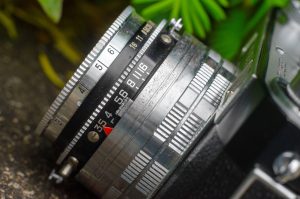
Despite the cloudy rangefinder, I had absolutely no trouble getting focus correct on this camera. In fact, all 18 shots were sharply in focus, even interior shots, which is something I couldn’t say about the Yashica. The shutter seemed to be working at the correct speeds as I was able to get correct exposure on almost all shots. The imags of the little boy is overexposed and was the only shot on the whole roll that shows a light leak. I’m not sure how you can have a light leak on just one image, but whatever the case, it didn’t show up on any other shot.
Perhaps my favorite image is the one the right, and one that I’ve also shot using the Vito II which I reviewed here. It’s an interior shot of a window in abandoned house near my work. I love the desecrated look of the room along with the ghostly curtains flowing in the breeze. Once again, getting focus correct and exposure in the dark room with a bright window was a snap.
Overall, my experience with the Brumberger was much better than I expected. This was a camera that came to me as a curiosity. One that I knew little about and one I assumed would be a “one and done” in my collection. I loved the dual stroke film winder, the top plate shutter release, and although the viewfinder was cloudy on mine, it did not impact my ability to get perfectly focused shots. My one regret with the Brumberger was rushing through half a roll that I shared with the Yashica 35. I didn’t think I would enjoy this camera as much as I did, and in hindsight, wished I had dedicated a whole roll to it. This is definitely a camera I will come back to again someday.
My Final WordHow these ratings work |
The Brumberger 35 is a misleadingly basic camera. It’s f/3.5 lens and simple design suggests a lackluster and uninspired camera, however when using it, it has just enough essential features and a clean and easy to use design that makes it a very effective compact camera. The Neokor lens produces wonderful images with just the right amount of a vintage effect to make really pleasing shots. Since the Brumberger 35 is an otherwise identical rebadge of a Neoca 2S, I imagine that everything I can say about this camera is true about both models. This camera isn’t easy to come by, but if one ever were to come your way, you should not dismiss it as a bottom of the line camera. | ||||||
| Images | Handling | Features | Viewfinder | Feel & Beauty | History | Age | |
| 1 | 2 | 1 | 0 | 1 | 0 | 30% | |
| Bonus | +1 for exceeding my expectations by such a wide margin, this camera is greater than the sum of it’s parts | ||||||
| Final Score | 8.8 | ||||||
Additional Resources
http://camera-wiki.org/wiki/Brumberger
http://camerapedia.wikia.com/wiki/Neoca_2S
http://fukucame.fan.coocan.jp/neoca2s.htm (in Japanese)
http://www.collection-appareils.fr/x/html/page_standard.php?id_appareil=11596 (in French)
http://www.mes-appareils-photos.fr/Neoca-2S.htm (in French)


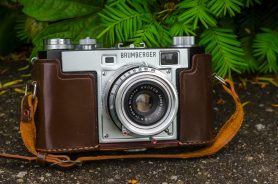
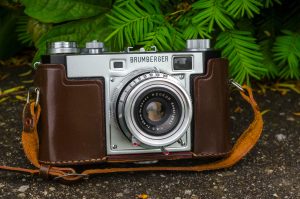


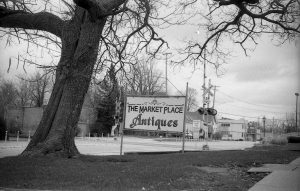
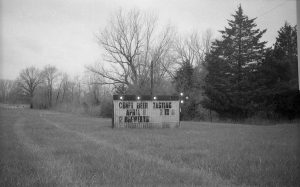
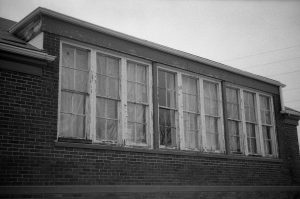


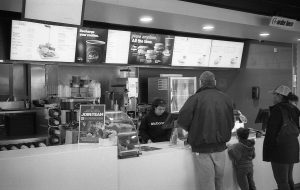
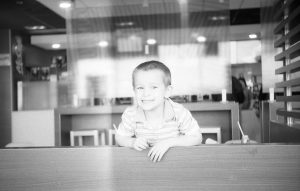
What a great review with incredible amount of in depth information!
I acquired a Neoca 2S some years ago, a bit rugged but with smooth focus and perfectly timed shutter (even down to one second exposure). The one thing lacking was a rangefinder patch. I don’t recall exactly what was the case, but I tend to believe that the rangefinder mirror was missing after opening the top. I got a proper piece of mirror cut to size and glued it into place, aligned the rangefinder and closed the top cover. The latter, however, took me about half a year since I did fully disassemble the cover including the winder spring. Reassembling this spring with the top plate proved to be my most challenging repair effort ever but after putting the almost-assembled camera away twice, I finally managed to get it back together and literally close the case.
I only recently got round to running some film through it. I still have to scan the negatives, but I already noticed some frame spacing issues in the beginning of the first roll. Hopefully the wind system has settled by now and my images prove to be of similar quality as yours.
Christian, that is great news to hear you got your Neoca running again. The rangefinder on these cameras is really basic. Like you said, getting a new mirror cut should restore it to near perfection. Mine actually could benefit from a new one as it’s existing beamsplitter is hazy.